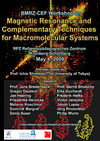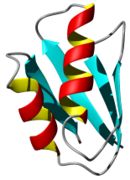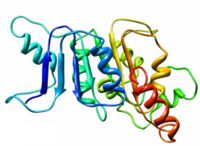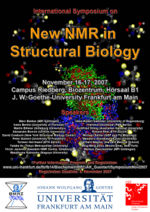News
From GuentertWiki
Contents |
2009
Job announcement (22.6.2009)
Workshop on Magnetic Resonance and Complementary Techniques for Macromolecular System 2009 (4.5.2009)
- The BMRZ and the Cluster of Excellence Macromolecular Complexes at the Goethe University Frankfurt (CEF) will hold a joint BMRZ-CEF Workshop. Lectures will be given by selected members of the BMRZ and by external speakers.
Seminar by Prof. Yuichiro Maéda (24.04.2009)
- Towards understanding the basic properties of F-actin based on high resolution structures
- Prof. Dr. Yuichiro Maéda, Structural Biology Research Center and Department of Biology, Nagoya University, Japan
- Actin plays various important cellular roles, among others, in muscle contraction, cell motility, neuron network formation, and cell division. In muscle, the actin filament plays the central roles in muscle contraction and its regulation. In non-muscle cells, actin is highly dynamic through transition between monomeric G-actin and filamentous F-actin. Movement is driven and force is exerted by “tread-milling”; simultaneous polymerization at the B-end and depolymerization at the P-end of F-actin. F-actin elongation is not controllable so that F-actin cannot be crystallized. Therefore a high- resolution structure of F-actin has never been known. Recently, we have made progress in the structural elucidation of F-actin. First, we have obtained a high-resolution structure of F-actin (Oda et al., 2009), which is based upon X-ray fiber diffractions obtained from highly oriented F-actin sols. Second, we have established a method for knowing cryo-EM structures at the ends of F-actin, and by employing this method, we have obtained the structure of a capping protein bound to the B-end of F-actin. Third, we have challenged a long-lasting problem and we have established a Sf9 based actin expression system to prepare actin variants. This enables us to know more details of how actin works. By combining these results, we are beginning to understand how actin works.
- Oda, T., Iwasa, M., Aihara, T., Maéda, Y., Narita, A. The nature of the globular- to fibrous-actin transition. Nature 457, 441-446 (2009).
Press releases (05.03.2009)
- Proteinstruktur in der lebenden Zelle bestimmt - NMR-Experimente erstmals in natürlicher Umgebung möglich
- Proteine bei der Arbeit beobachten
- Sakakibara, D., Sasaki, A., Ikeya, T., Hamatsu, J., Hanashima, T., Mishima, M., Yoshimasu, M., Hayashi, N., Mikawa, T., Wälchli, M., Smith, B. O., Shirakawa, M., Güntert, P. & Ito, Y. Protein structure determination in living cells by in-cell NMR spectroscopy. Nature 458, 102-105 (2009)
Seminar by Dr. Hélène Van Melckebeke (16.01.2009)
- High resolution structure of the HET-s(218-289) prion amyloid fibrils using solid-state NMR
- Dr. Hélène Van Melckebeke, Physical Chemistry, ETH Zürich, Switzerland
- Prions and amyloid fibrils are associated with several animal and human diseases. Despite the paramount importance of the structural aspects, no atomic resolution structure of a prion in its fibrillar state has been reported yet. Solid-state NMR is to date the only technique capable of obtaining the structure of such non-crystalline and non-soluble compounds. We have obtained the structure of amyloid fibrils produced in vitro from the prion-forming domain (residues 218-289) of the HET-s prion from the filamentous fungus Podospora anserina using solid-state NMR techniques. These results give a structural explanation of the stability of the HET-s(218-289) fibrils. In the presentation, both methodological and structural aspects will be discussed.
- Wasmer, C. Lange, A., Van Melckebeke, H., Siemer, A. B., Riek, R. & Meier, B. H. (2008). Amyloid fibrils of the HET-s(218–289) prion form a β solenoid with a triangular hydrophobic core. Science 319, 1523–1526.
2008
Seminar by Prof. Masatsune Kainosho (14.10.2008)
- Recent progress in the SAIL approach to study side-chain conformations of proteins and protein complexes
- Prof. Dr. Masatsune Kainosho, Nagoya University and Tokyo Metropolitan University, Japan
Seminar by Dr. Hideo Iwai (15.09.2008)
- Segmental and fractional isotopic labelling of proteins
- Dr. Hideo Iwai, University of Helsinki, Finland
- Dr. Iwai will present two new approaches of segmental isotopic labelling and fractional 13C labelling for NMR assignments of proteins. Recently, he has developed a robust approach for segmental isotopic labelling using protein trans-splicing, which could open possibilities to study a domain of intact proteins without dissecting into smaller globular domains. He will also present a novel concept to classify residue types in NMR spectra by the use of fractional labeling, which is distinct from routinely used chemical shifts and spin topologies for identifying residue types.
Press release (11.08.2008)
- Pannenhilfe der Antibiotikumproduktion entschlüsselt
- Pressemitteilung by the Volkswagen Foundation.
- Pressemitteilung by the Goethe University Frankfurt am Main.
- Koglin, A., Löhr, F., Bernhard, F., Rogov, V. R., Frueh, D. P., Strieter, E. R., Mofid, M. R., Güntert, P., Wagner, G., Walsh, C. T., Marahiel, M. A. & Dötsch, V. Structural basis for the selectivity of the external thioesterase of the surfactin-synthetase. Nature 454, 907–911 (2008)
Seminar by Prof. Koichi Kato (03.07.2008)
- NMR and sugar library approaches for structural glycomics
- Prof. Dr. Koichi Kato, Nagoya City University, Nagoya, and Institute of Molecular Science, Okazaki, Japan
- Many proteins in the living systems are covalently linked to carbohydrate moieties. NMR spectroscopy can potentially provide information on the structure and dynamics of glycoproteins in solution but has also been hampered by spectral overlap and low sensitivity. To cope with this difficulty, we have been developing a systematic method for structural glycobiology by combined use of stable-isotope-assisted NMR spectroscopy and multi-dimensional HPLC techniques for glycosylation profiling and sugar library construction. Our projects address the underlying mechanisms of
- Glycoform-dependent effector functions of immunoglobulin G glycoproteins as therapeutic antibodies
- Glycoprotein-fate determination in cells through the interactions with a variety of intracellular lectins
2007
Symposium on New NMR in Structural Biology 2007 (16-17.11.2007)
- Center for Biomolecular Magnetic Resonance (BMRZ), Cluster of Excellence Frankfurt Macromolecular Complexes, Johann Wolfgang Goethe-University Frankfurt am Main



